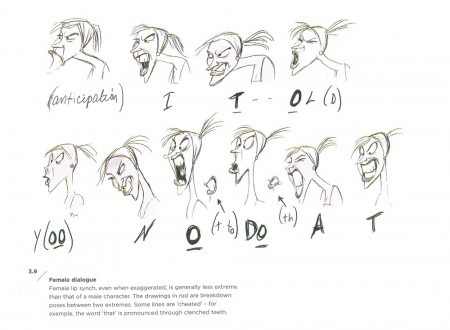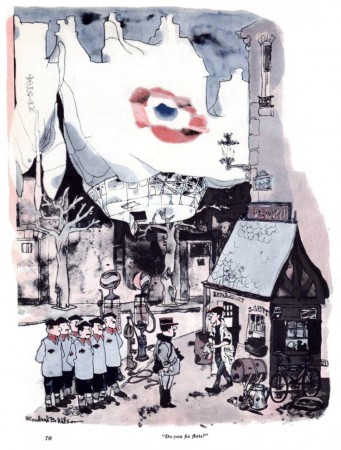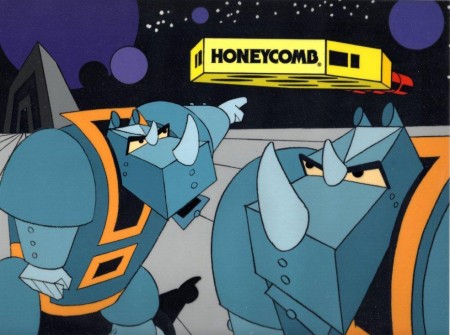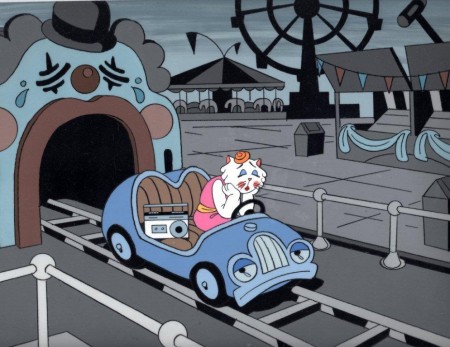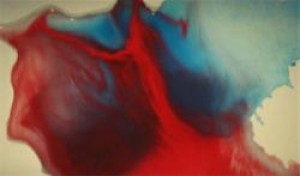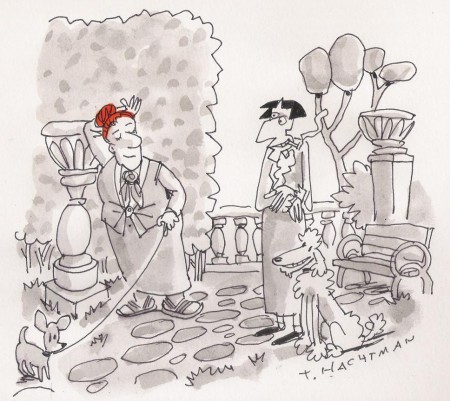Category ArchiveCommentary
Books &Commentary 03 Sep 2010 08:19 am
Animated Performance
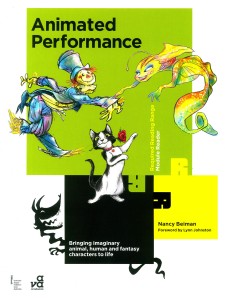 - If I had to select one book, today, that I would reccomend people read to learn about about the art of animation, I’d probably pick Nancy Beiman‘s latest tome. It’s a bona fide gem. It’s not like the Preston Blair/Eric Goldberg model where poses for walk cycles and skips and generic movements are blocked out for you. This book does as its title suggests, it shows you how to get a performance out of your characters. Naturally, it would probably help if you already knew the basics (see the Preston Blair/Eric Goldberg model for that.)
- If I had to select one book, today, that I would reccomend people read to learn about about the art of animation, I’d probably pick Nancy Beiman‘s latest tome. It’s a bona fide gem. It’s not like the Preston Blair/Eric Goldberg model where poses for walk cycles and skips and generic movements are blocked out for you. This book does as its title suggests, it shows you how to get a performance out of your characters. Naturally, it would probably help if you already knew the basics (see the Preston Blair/Eric Goldberg model for that.)
There are numerous conversations with the likes of Art Babbitt, Jamaal Bradley and Ellen Woodbury to give you some info on how they got performances out of their characters. Babbitt, naturally, talks about Goofy and his original animation of that character. Bradley discusses animating the “House” in Monster House. Ellen Woodbury talks about Zazu in The Lion King. There’s quite a lot of material there, and Nancy uses it all to extrapolate her lessons.
The book is filled with lots of sketches and examples of material being discussed. The drawings are Nancy’s when she has something specific to detail; if she can find an example from an existing film, she uses that. It’s a solid book with strong material that is rarely discussed in How-To animation books.
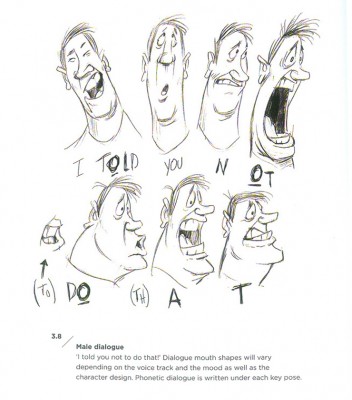
Here Nancy gives the example of a male and
a female saying the same line.
My complaint might be that some of the thumbnails are printed relatively small so it’s hard to see some of the material. (Of course that also has to do with my aging eyesight.) But there’s so much packed into this book that I can’t imagine them having the room to print it much larger.
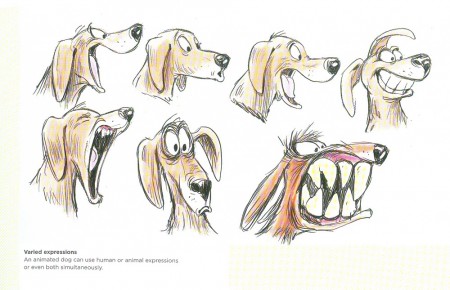
Animals are given equal space.
The book concerns itself with the differences between the sexes, four legs vs. two and how to portray animated animal motion, moving inanimate objects, weight and weightlesssness, animating multiple characters and crowd scenes. That’s quite a lot to tackle, and the book seems to get it right in Nancy’s hands.
Nancy Beiman desrves strong kudos for this book, and any animation student – 2D or 3D – should own a copy.
Commentary &Independent Animation 31 Aug 2010 07:43 am
My Dog Tulip – 3 Reviews
- Rather than have a single review of Paul and Sandra Fierlinger‘s feature film MY DOG TULIP – which opens at the Film Forum on September 1st – I decided to get the two animators in my studio, Matt Clinton and Katrina Gregorius, to see the film and give their reviews as well. Hoping this would give a non-biased view of the film and a chance for you to see it through the eyes of pencil animators who happen to be working digitally. I hope this exercise is illuminating. I think it is.
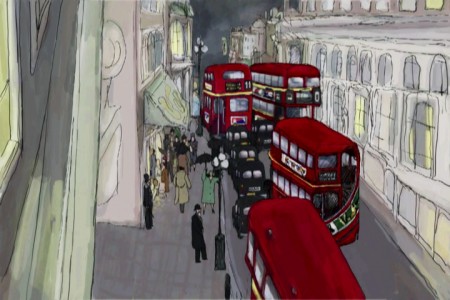
Matt Clinton
My Dog Tulip is a wonderful new animated film from Paul and Sandra Fierlinger. I’ve enjoyed their particular style of animation ever since I saw Still Life With Animated Dogs on TV years ago. The drawings were so sincerely animated that it surprised me, and the film stayed in my memory. The locomotion and behavior of dogs is something that seems to flow effortlessly from Paul Fierlinger’s pen. I love seeing that sort of thing in animation – where it feels natural, and nothing is worked over too much.
It’s all there in My Dog Tulip. I was very impressed with the animation, which is loose and full of life. It was animated paperlessly using TVPaint. (This film is quite a showcase for that software, and I hope it becomes more widely known.) There are a few different visual styles that pop up in the film. Much of it is drawn in a realistic style. It takes a lot of skill to be able to animate so much footage of a realistic dog who is moving around spatially. Fierlinger excels at this, keeping the animation spontaneous and giving a lot of character to the dog. Tulip doesn’t just show up and bark, like some other ruddy dog actors. She’s a pro. Fierlinger also animates some parts in a simpler style, made to look like doodles in a journal. These scenes were often very funny, and fun to watch. I laughed at Tulip prancing around in a skirt urinating on everything in sight. She is like a young child.
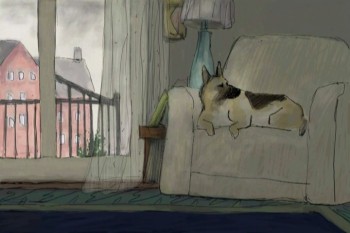 Fierlinger allows time in the film for things to happen, which is rare in animated features. I really get annoyed at the spastic actions and pacing in some animated films; I don’t like leaving the theater with a headache and feeling exhausted. My Dog Tulip is not like that. For example, in one sequence, Ackerley and Tulip are being driven in a sidecar motorcycle to the country home of Captain Pugh. Instead of just showing them departing and arriving, we get to see their silent journey for quite a long time. This lets the audience get a feel for the world that Tulip lives in. Moments like that combine to give you a thorough understanding of the place.
Fierlinger allows time in the film for things to happen, which is rare in animated features. I really get annoyed at the spastic actions and pacing in some animated films; I don’t like leaving the theater with a headache and feeling exhausted. My Dog Tulip is not like that. For example, in one sequence, Ackerley and Tulip are being driven in a sidecar motorcycle to the country home of Captain Pugh. Instead of just showing them departing and arriving, we get to see their silent journey for quite a long time. This lets the audience get a feel for the world that Tulip lives in. Moments like that combine to give you a thorough understanding of the place.
The background paintings are stunning. They were painted by Sandra Fierlinger directly in TVPaint. That software comes with many natural media brushes that you can customize. She used her expertise in painting and color styling to create, in this software, backgrounds that are very classy and sophisticated. I noticed that she created well-placed shadows throughout the film. In his study, Ackerley walks in and out of shadows cast on his rows of books. In another scene the shadows from unseen clouds move across a field where Ackerley is standing. These details add some depth and atmosphere. It’s nice to see such a focus on this. The paintings themselves are not overly detailed but they give you all you need. The film looked great up on the big screen.
It’s clear that these two artists compliment each other very well. It’s a huge achievement that just two people can make a feature film in their home studio, one animating, the other painting. In the press notes, it says that the producers had contacted the Fierlingers and asked them to choose a classic book to adapt as a feature film. I like the thought of that; picking a book and going for it. It would be fun to try. I believe that the Fierlingers are now at work on a film about Joshua Slocum’s book Sailing Around the World Alone. I’m looking forward to seeing how he handles animating all that water. Rough seas are probably haunting his dreams by now.
Christopher Plummer’s narration of My Dog Tulip is notable. There is a large amount of narration and he gives it a bold flourish! J.R. Ackerley’s sense of humor comes bursting out of Plummer’s performance. The rest of the cast is top notch as well.
I think that most dog owners will see a lot that they can relate to in My Dog Tulip. I’ve had a lot of American Eskimo experience. Great dogs! Our first one loved to be wild in public. She loved to make a scene. At home she behaved pretty well and we didn’t mind her nipping at all. You really do learn to love all the unique things about your own dog – their personality and certain tendencies. My Dog Tulip is all about this. Tulip comes into J.R. Ackerley’s life and changes it in unexpected ways. There’s a big impact that Tulip makes. Near the start of the film, Ackerley is racing, racing, racing home to be with his dog, who is waiting. She knows what time it is. The door swings open and the day can finally begin in earnest! The film is an account of their friendship. That’s something anyone can relate too.
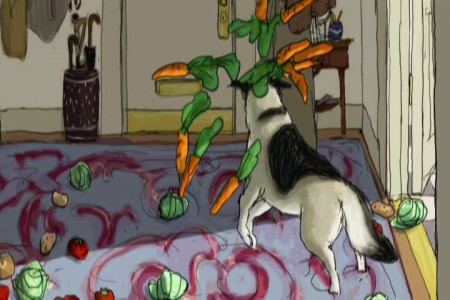
Katrina Gregorius
Humorous and full of tender moments Paul and Sandra Fierlinger’s new feature, My Dog Tulip, is an honest account of the relationship between J.R. Ackerley and his dog, Tulip. The film pulls you in as you share the experiences Ackerely goes through in trying to understand his new dog and eventual companion.
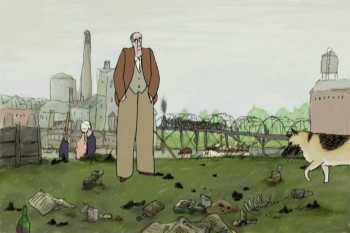 My Dog Tulip begins by showing us the loving relationship between Ackerely and Tulip. Ackerely is rushing to get home and Tulip is excitedly waiting by the door for him. The story then takes us on a journey through the “couple’s†life. Mr. Fierlinger has captured the essence of owning a dog and he isn’t afraid to show it like it is. The feature is filled with scenes of Tulip defecating and urinating all over the place. While some scenes may have been too much for me, I can’t say that they were entirely unnecessary. I’m sure anyone who’s ever owned a dog, cat or any pet can relate.
My Dog Tulip begins by showing us the loving relationship between Ackerely and Tulip. Ackerely is rushing to get home and Tulip is excitedly waiting by the door for him. The story then takes us on a journey through the “couple’s†life. Mr. Fierlinger has captured the essence of owning a dog and he isn’t afraid to show it like it is. The feature is filled with scenes of Tulip defecating and urinating all over the place. While some scenes may have been too much for me, I can’t say that they were entirely unnecessary. I’m sure anyone who’s ever owned a dog, cat or any pet can relate.
The film takes on a few different styles throughout, but I especially enjoyed the “yellow pad scribblesâ€-style. These sequences were meant to be from Ackerley’s perspective and in them Tulip was depicted walking on two legs and wearing a dress, almost human. For me this emphasized the closeness that these two had. Tulip wasn’t only Ackerley’s dog but she was also his friend and companion.
Overall My Dog Tulip is a very touching and heart-warming story of finding love and friendship from the most unexpected places.
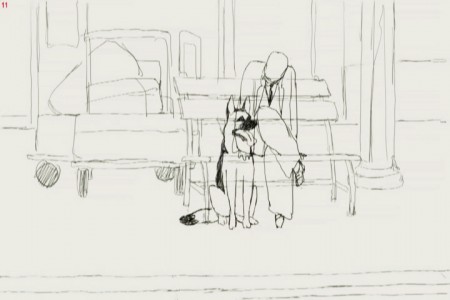
From the pencil test of the film
Michael Sporn
Paul Fierlinger has been making animated films independently for more than 50 years. Recently, his work has turned to the long form. He’s done a number of half-hour shows for ITV which have been aired on PBS local stations. Drawn from Memory, Still Life With Animated Dogs and A Room Nearby were strong programs that brought some decided interest to Fierlinger’s work.
My Dog Tulip, a theatrical feature, came via a couple of producers willing to invest a million dollars in a well-known book adaptation. The book by J.R. Ackerley was more famous in England, but Paul and Sandra Fierlinger sought out the title. The film started with fists and stops, then finally got going after the animators produced a short piece of beautiful animation. The producers were sold, and the film went forward.
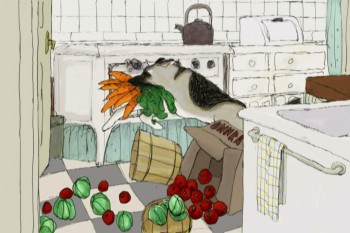 With a strong cast of voice actors, including Christopher Plummer, Isabella Rosselini and, the late, Lynn Redgrave the film sparkles. The backgrounds are a treat, particularly at the start of the film looking at some of the beautiful shots of London.
With a strong cast of voice actors, including Christopher Plummer, Isabella Rosselini and, the late, Lynn Redgrave the film sparkles. The backgrounds are a treat, particularly at the start of the film looking at some of the beautiful shots of London.
The film moves into its story about the tight relationship between a man and his German Shepard. At first, there’s a lot of anxiety between the two, but soon they warm up to each other and become almost too close. Plummer’s narration is just excellently delivered and totally conveys the conflict in the relationship.
The film seems to take a strange turn in that it becomes almost too concerned with the scatalogical elements of dog-ownership. We’re treated to the dog’s constant urination, pooping and many attempts at mating. This gets a bit off-putting for some, but the film uses it to detail the tight marriage of man with dog.
Ultimately, the film is a peculiar one. It’s beautiful in its graphics; the animation is often stellar – as expected from Paul, and Sandra shows that she can paint glorious backgrounds with the best. The artwork just glistens. However, the story is unlike anything that’s been seen on screen before; it’s adult. This is surely no 101 Dalmatians – purposefully.
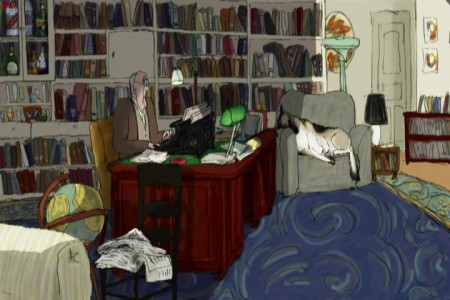
Anytime an individual takes on the task of producing, directing, animating, and coloring an animated feature, it’s a big deal. We’re getting to see this more and more now that digital technology has made it a tad easier for those folk. Something that has to be said is that they are determined to get a film finished. That kind of energy has always produced inspiration in me. I’ve gone to see any such film, just because I feel obligated. Obligated to the art of animation.
There is definitely an obligation, in my mind, for everyone reading this blog to get out and see this film. Support your own.
There was an excellent article in the NYTimes about the methods of TVPaint used for producing the artwork of this film.
The NYTimes critic Stephen Holden reviews the film and makes it a “critics pick” as one of the best movies in the market.
Books &Commentary &Festivals &Independent Animation 21 Aug 2010 07:30 am
Idiots/Eastman/and Chicken Fat
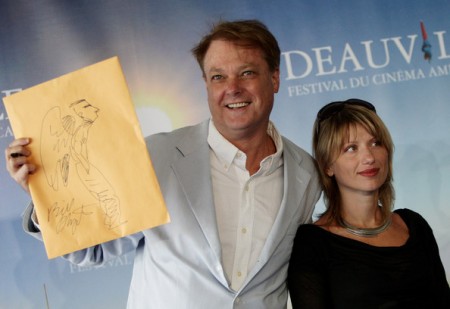
Bill Plympton and Biljana Labovic during the Deauville, Film Festival in France.
- Bill Plympton called to say that he finally has a NY theater date for his feature Angels and Idiots. This film has played the Festival circuit and is now about to make its theatrical presence felt.
The IFC theater in NY will screen the film beginning the week of October 6th. We have to turn out for the film to make sure that the IFC will extend the run. (They usually do that if they sense there’s an audience. We know there’s an audience – we just have to turn out.)
The film will also open in LA at the Laemmle Sunset 5 – Opening October 26th, 2010.
I hope to have an extended interview with Bill, soon, about the making of this feature. Keep watch. Meanwhile AWN features Idiots’ Diary. This is a diary Bill is keeping about the distribution of the film.
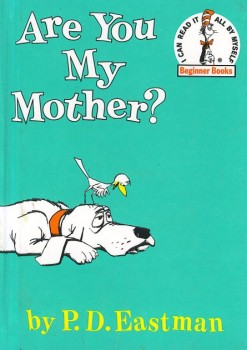 - I received a nice note from Tony Eastman the other day:
- I received a nice note from Tony Eastman the other day:
- Sue and I have put together a website for my father’s books: pdeastmanbooks.com
Its purpose is to entertain/inform, and at the same time sell books. There really wasn’t a place where you could see all of his books together, plus we thought a short biography (appropriate for children) and a way to get in touch with his family would be useful. I put together the P. D. caricature on the home page from two self portraits he had done.
In case you don’t know who P.D. Eastman was, I suggest you take a look at his film resume at IMDB. After working at Warners cartoons, he became integral in the start of UPA and the story writing of many of their best films. Oh, and he competed mightily with Dr. Seuss in writing MANY best selling children’s books.
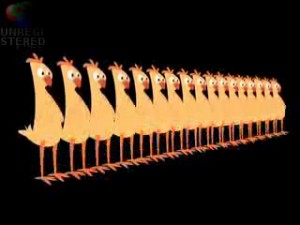 - Katrina Gregorius, an animator and artist in my studio, helped out her friend, Theresa Loong, a member of the Film Shop in Brooklyn, in making a music video. The video is mostly live action with animated bits to spark it up – and believe me it does. The song is Robert Preston singing Chicken Fat “The Youth Fitness Song” by Meredith Willson of “The Music Man” fame. The song was commissioned by President John F. Kennedy for the newly formed President’s Council On Physical Fitness in 1962. A copy was sent to every school in the United States to be played over the intercom so students could do calisthenics to it.
- Katrina Gregorius, an animator and artist in my studio, helped out her friend, Theresa Loong, a member of the Film Shop in Brooklyn, in making a music video. The video is mostly live action with animated bits to spark it up – and believe me it does. The song is Robert Preston singing Chicken Fat “The Youth Fitness Song” by Meredith Willson of “The Music Man” fame. The song was commissioned by President John F. Kennedy for the newly formed President’s Council On Physical Fitness in 1962. A copy was sent to every school in the United States to be played over the intercom so students could do calisthenics to it.
You can see the video here.
Commentary 14 Aug 2010 08:20 am
Rauch, O’Neill, Goro & The Rescuers
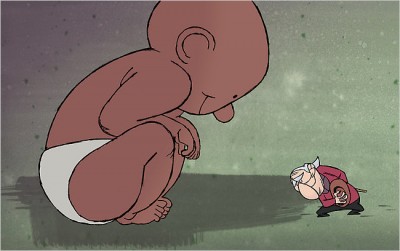
Mike and Tim Rauch have some more celebrating to do. Not only has their series of animated shorts been picked up by PBS’ POV, their story has made it to the NYTimes for the second time in a week. Could you ask for better publicity?
Together with Storycorps, the two have been animating the sound tracks and stories that people have volunteered to Storycorps. The results are human and dynamic.
The animation style they’ve chosen to use belies the natural soundtracks with very cartoon styling and makes for an interesting mix. These shorts are well worth viewing, and you should check out the PBS schedule of POV, in your area.
Check out the Rauch Bros. website.
.
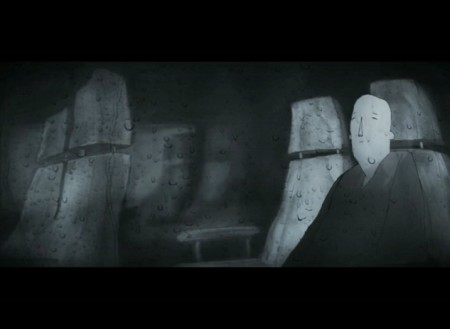
- I’d received this letter from Eamonn O’Neill in Ireland.
- My name is Eamonn O’Neill. Im a 22 year old animator and film maker currently based in Dublin Ireland (Although at the moment I am just about to move to London, England to begin an MA in animation direction at the Royal College of Art!)
Last year I made a film called My Day which was featured on Cartoon Brew. You commented on the film at the time and I was delighted to see you enjoyed my film as I’ve been reading your blog for a number of years now.
Fast forward a couple of months and I had the chance to meet with John Canemaker whilst he came to Ireland to lecture at my old college. John had also seen my film online and through that we came to talk about you, we spoke about a film which I had recently finished at the time and he said I should contact you at some point.
Which leads me to why I am mailing you! I recently posted online my 2009 graduate film On the Quiet which I thought you might like to watch.
The film On the Quiet is on VIMEO, and you should take a look at it. It’s well animated and has an intelligence behind it.
.

- Goro Miyazaki, the son of Hayao Miyazaki, has an animated feature opening today in selected theaters across the country. In NY, it’s at the Angelica. Tales of the Earthsea received mixed reviews in NY. Stephen Holden in the NY Times wrote:
- The movie’s hand-drawn animation and watercolor palette give the story a flat, pictorial grandeur that is pleasant to contemplate though rarely eye catching.
Instead of a shallow story of good versus evil, Tales From Earthsea is a fable about facing your own dark side and accepting your mortality and the limitations of the human condition at a time when technology stokes our fantasies of omnipotence and immortality. As useful as that message may be, it is imparted with more earnestness than passion.
At least it sounds like it has a story, unlike many of the recent cg swipes at cartooning the big budget studios have given us.
.
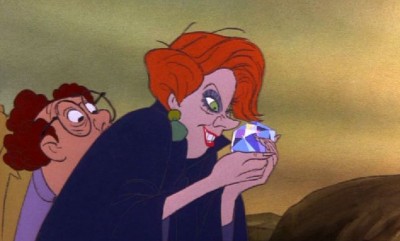
- Hans Perk on his invaluable site, A Film LA, has begun posting the animator drafts of the Disney feature, The Rescuers.
The film was never much of a favorite of mine. The Woolie Reitherman direction is so activity oriented, and the film as a whole just gives us set pieces for the masterful animators to dance around.
Milt Kahl‘s Medusa is excellent, though one feels he’s just trying to compete with the brilliant work Marc Davis did with Cruella DeVil on 101 Dalmatians. Ollie Johnston does fine work, but it’s as sentimental as always. Frank Thomas, as always, was superb.
Too bad we don’t have much the equivalent today.
Animation &Bill Peckmann &Commentary &Independent Animation &Layout & Design 07 Aug 2010 08:00 am
Leftover Bits & Pieces
- Here are some bits and pieces left over from the week.
Bill Peckmann sent me some beautiful art this week, and though the pieces have nothing in common, I still thought it’s worth showing the quality of the great art done in the 60s & 70s whether for spot cartoons or animated spots.
These are Bill’s comments from his email:
- “I thought you’d get a kick out of this, here’s RBW’s gag in the Dec. ’61 issue of Esguire and the next will be the same gag as it appeared in 2 colors in his book. You can see how much was lost.”
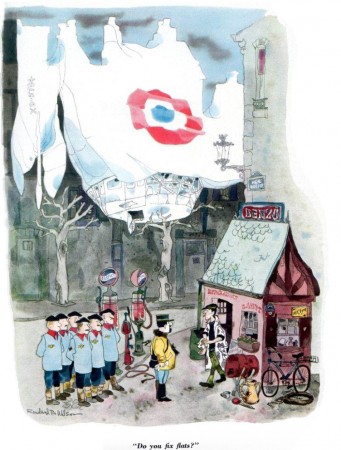
(Click any image to enlarge.)
Then on another post Bill sent me these treasures from Phil Kimmelman & Associates (PK&A).
Again, Bill’s words:
- “Thought you might have an interest in seeing these. They are 3 cel set ups from the days at PK&A in the ’70′s. Two I designed for Honeycomb Cereal, the third a Mexican spot for Eveready Batteries. The BG’s were also done with Cel Paint. Sadly the color reproduction never looked so good as it does now with scanning, remember those 16mm Answer Prints of yore, made for TV viewing, the original colors never came close to what we had in mind.
These set ups were made for “Studio” ads.”
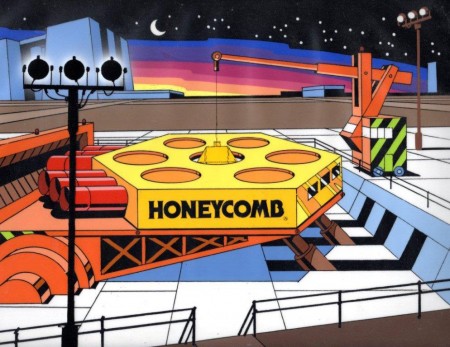 1
1
_________________
Greg Kelly and I have been exchanging emails for quite some time now. He’s done many short films and sends them for comment. His latest film is now posted on Vimeo, and I thought I’d like to commend you to take a look. He’s working hard at his animation, and I can only encourage him wholeheartedly. It isn’t easy to make a film, and he keeps doing it.
He wrote of this piece:
- “It is frame-by-frame, hand drawn in Flash and on twos with a lot of hand adjustments. It isn’t typical for what I do though it is another cartoon in an 8 year long series of shorts featuring one or both of these characters.”
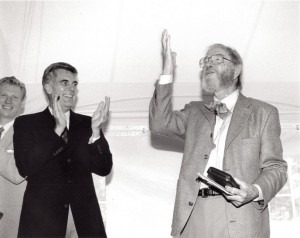
- John Canemaker has another post up at the Print Magazine site. This month it’s a good piece about Chuck Jones at the MacDowell Colony. It tells of Jones winning the MacDowell Medal in 1997.
Canemaker, who led the advisory panel in selecting Jones, prints his introductory speech to Jones and includes links to several WB shorts by the Master. It’s worth checking out if you have any allegiance to Jones’ work.
I’m sure anyone who is interested has already read this, but Michael Barrier has his review of Toy Story 3 up at his site. Since I’m in total agreement with what he has to say, I can only direct you to the link.
Books &Commentary &Disney &Story & Storyboards 02 Aug 2010 10:08 pm
Joe and Joe
- Today is the day that John Canemaker‘s book, Two Guys Named Joe: Master Animation Storytellers Joe Grant and Joe Ranft officially hits the stores. I urge you to take a look and go for it. The book is great.
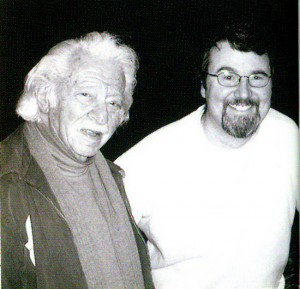 - It was about nine months ago that John Canemaker let me read the galleys of his new book, Two Guys Named Joe: Master Animation Storytellers Joe Grant and Joe Ranft. I’d been aware of the book for a couple of years now, and whenever I’d heard John talk about it I wondered how the two guys fit in together to make a book. When I was handed the galleys, I moved slowly ahead with some trepidition.
- It was about nine months ago that John Canemaker let me read the galleys of his new book, Two Guys Named Joe: Master Animation Storytellers Joe Grant and Joe Ranft. I’d been aware of the book for a couple of years now, and whenever I’d heard John talk about it I wondered how the two guys fit in together to make a book. When I was handed the galleys, I moved slowly ahead with some trepidition.
I basically knew who the two Joes were from my reading and my NY attempts to keep up with the Hollywood system. Joe Grant was an old timer who’d dominated the Disney modelling department (the only time there was a department exclusively for model sheets), and he’d come back to act as one of the wizened artists helping to shape the new “Renaissance” in the animation community. Joe Ranft was one of the key CalArts guys who’d gone through the Disney system on his way to Pixar where he helped to shape that studio. There’s no doubt he was key to Toy Story, A Bugs Life and Monsters Inc.
What connection would John Canemaker have for tying these two together? Would that connection be enough to fill a book?
Of course, all such conjecture was stupid on my part. The book, as it turned out, is one of John Canemaker‘s finest, and that’s saying a lot. John, after all, is one of the best of our animation historians. His material is well researched, his facts are accurate, and his information is always pertinent and absorbing. He is also a good writer. He tells a story and reveals his information as any good writer would. There’s a solid construction to all of his books, and he lets you into the book in a comfortably relaxed way so that you’re absorbing the story and facts all together, and you are pulled into the book. This is the greatness of Two Guys Named Joe.
As for the connection, John explains that well. Not only, of course, within the book, but he had this succinct statement to make in an interview with Amid Amidi: “I saw the possibility of an overview of the history of storytelling at Disney and Pixar through a very human story of two artists straddling the 20th and 21st centuries.” And that’s exactly what John uses the book to do. He wants to really upchuck the earth of the story departments of both Pixar and Disney, and he does a good job of it.
I’ve now read the book twice. Once in galley form, once in final book form. The book is a rich-looking item full of the finest artwork from storyboards, printed material and developmental art. It’s a gorgeous book.
However, the real gold is in some of the writing and treasured bits that John has dug up to support his material. Here, for example is a small piece about Alice In Wonderland’s story development:
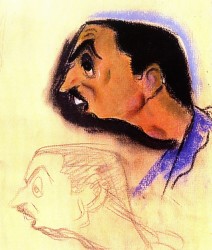 A March 15, 1939, story conference transcript reveals Walt’s frustration with the project:
A March 15, 1939, story conference transcript reveals Walt’s frustration with the project:WALT: (To Joe) Have you been through A//ce in Wonderland lately?
JOE: No. I’ve been through the script though. I think there are some pretty good situations in this.
WALT: Yes, and some, too, that are not so good.
JOE: I like the stuff on the disappearing cat—swell possibilities in that.
WALT: Yes. Let’s see. What are the good situations?
JOE: The tea party stuff is good.
WALT: Yes, the tea party is to me the best. . . You
know, I think we’re missing a hell of a lot in the stuff that is our medium. . . everything isn’t dialogue. Talk, dialogue business that depends on dialogue, hinges on dialogue.
Disney then tore into an unfortunate writer named Dana Coty.
WALT: I’m saying that to you because I think maybe
you’re the one that’s responsible for a lot of silly business that has no basis on anything funny.
DANA: Well, in the duchess’s house, I wrote that very loosely to begin with, Walt.
WALT: I don’t give a damn how you wrote it. It’s what we’re driving at. If it hasn’t got a basis for something funny, don’t write it! There’s no use writing the thing and then alibi-ing for it afterwards. It just throws us off the, track. Don’t just write anything to fill up some pages. We had the same criticism, the last time we were together.
John uses this anecdote to not only say something about Disney, himself, but the way he communicated with Grant and the hostility he might display for others. He did not mince words or waste time where he thought it was wasted. They were trying to solve the problms they saw in Alice In Wonderland, but we learn that Grant, Huemer and others felt that Disney was the problem. They felt he didn’t quite understand the Victorian humor of the original and tried to gag it all up. It’s just one wonderful excerpt dug deep in the book.
Another gem of a sequence involves Joe Ranft. It’s the point just when the Pixar artists are trying to sell Toy Story to the Execs at Disney. They’re doing everything in their power to make the film story good while placating the Disney people, and they’re having a hard time of it.
- Disney insisted the production move to Los Angeles so the studio could oversee things. “And give us more notes,” Ranft lamented.
Lasseter, whose “heart was broken,” begged for a two-week reprieve to turn things around. After obtaining Disney’s skeptical permission, Lasseter, Ranft, Docter, and Stanton resolved to “make the movie we want to make!”
. . .
The process included writing, gathering more material, constant meetings, weeding out, refocusing, and . . . more meetings. “Two or five heads are better than one,” Ranft believed. “If you can work together without killing each other, you an accomplish a lot.”
Going forward, Pixar gladly accepted notes from Disney and welcomed participating in brainstorming sessions with their artists. “But,” Ranft said, “we’d go away and really think about [the notes]. A lot of times we’d go, ‘No. Here’s the real problem!’ And it was even deeper than the notes. ‘And here’s how we’re going to fix it.’”
Regarding the creative process, Ranft once said, “It’s a challenge. The final product is the goal you’re searching for. [Your little sequence is] gonna get smashed, trashed. It’s gonna come apart for the good of the final film . . . it’s a paradox. You’ve got to put yourself into it, and then you’ve got to take yourself out of it. Be objective and not be hurt.”
And that’s the point of the two guys. They understood the value of the story and the center of the films they worked on and over. Nothing mattered, including personal insult, as long as the story came out right. They were film artists and knew how to get what they needed to complete their goals.
My personal preference is to want to know more about the old timer and to learn more about the golden age. However, it’s totally my bias, and the proof of this book’s success is that I was completely absorbed by all that was written about both men.
This is more than a good book. Anyone in love with animation should own a copy and read it carefully. There’s a lot there, and it’s all good. It’s stunningly designed with beautiful animation art treasures well displayed.
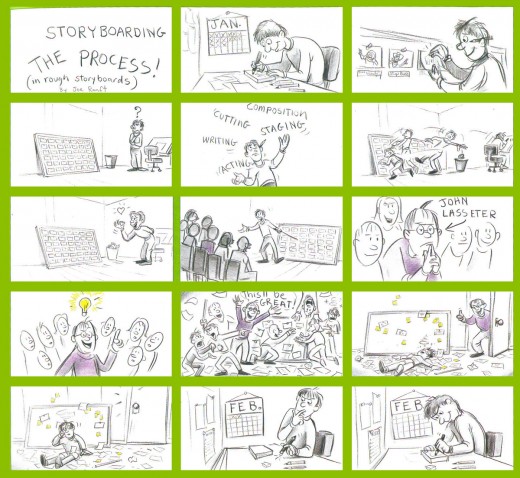
A telling board by Ranft.
________________
Amid Amidi offers an excellent interview with John Canemaker on the subjects of the book at his Cartoon Brew site. I recommend you all read it.
There’s also a video promo you can catch on YouTube if you’re more visually oriented.
Commentary &Independent Animation 27 Jul 2010 08:27 am
Prayers and Tulips
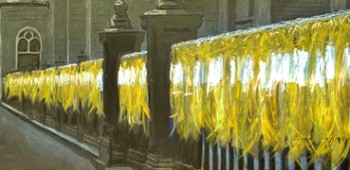 - Dustin Grella is a young film maker whose independent short, Prayers for Peace is now available on Vimeo, here. It’s a beautiful animated short that should be seen by any visitors to my blog. It’s currently on the Festival circuit, having been screened at Annecy, Stuttgart, Anima Mundi, and Mostra Lisboa, among others.
- Dustin Grella is a young film maker whose independent short, Prayers for Peace is now available on Vimeo, here. It’s a beautiful animated short that should be seen by any visitors to my blog. It’s currently on the Festival circuit, having been screened at Annecy, Stuttgart, Anima Mundi, and Mostra Lisboa, among others.
Mr. Grella takes his inspiration from William Kentridge rather than Walt Disney, and he makes a solidly strong debut with this film which was his Masters thesis at SVA. If you go to his site you can see other film samples he’s created.
The message of this film is in the title, Prayers for Peace. And we’re still praying. After seeing the docfeature, Restrepo, I could only come out of it depressed, wondering what the hell we’re doing there.
This guy has to be ecouraged and pushed to go on. I look forward to Mr. Grella’s next film. The man uses his brain and tries to animate from life not other cartoons. A rarity in today’s community.
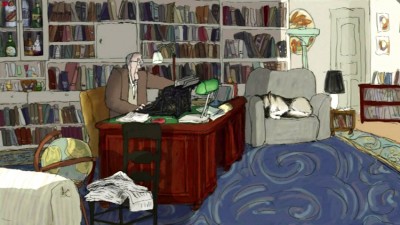 - Speaking of drawing from life, Paul and Sandra Fierllinger‘s feature, MY DOG TULIP, is the first acquisition of the newly reopened New Yorker Films and will open at New York’s Film Forum on Wed, September 1st through Tues, September 14th.
- Speaking of drawing from life, Paul and Sandra Fierllinger‘s feature, MY DOG TULIP, is the first acquisition of the newly reopened New Yorker Films and will open at New York’s Film Forum on Wed, September 1st through Tues, September 14th.
MY DOG TULIP was written, directed and animated by award-winning Philadelphia filmmakers Paul and Sandra Fierlinger. As we all know, they did all of the artwork themselves. The film has been seeking a distributor for the past year, and they’ve found a good one that’ll give it special concern. Getting the New York reviews in early September will be helpful. Hopefully, this one will be eligible for Oscar consideration.
I’ll give the film more attention and review it when it opens.
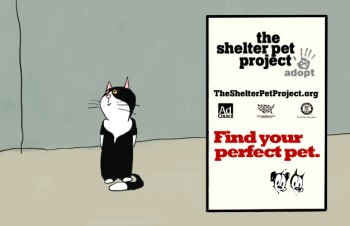 If you’d like to see some other recent work by the Fierlingers, go here to see some 6 short pieces, called “Shelter Stories”. These pieces were done in collaboration with MUTTS‘ cartoonist Patrick McDonnell. Here’s what Paul wrote about these pieces:
If you’d like to see some other recent work by the Fierlingers, go here to see some 6 short pieces, called “Shelter Stories”. These pieces were done in collaboration with MUTTS‘ cartoonist Patrick McDonnell. Here’s what Paul wrote about these pieces:
- “This is something new for us because it is the first time I had to draw someone else’s cartoons. In this case it is the art of Patrick McDonnell, of the “Mutts” cartoon strip and books. These are six Shelter Stories, PSA’s (Public Service Announcements) urging people to adopt their pets rather than buy them from breeders. Our specific assignment was to communicate that shelter animals are normal, healthy pets that have ended up in shelters due to unhappy circumstances of their owners, rather than coming from cruel treatment, and that they often make the best pets.
All the stories are lifted off of Patrick’s strips, which heavily relied on written word, sometimes comprising of three panels of the same talking head. It was up to us to give the theme a background story. Patrick was a very generous collaborator, not insisting that we stay 100% on model, which would have been often difficult anyway because his cartoons often don’t even have legs. He also wanted me to employ close to real animal locomotion so we agreed that in some instances my drawings might drop out of model completely, only to return to model whenever the action would stop.
The music and sfx is by Shay Lynch, the stories are written by Patrick and Sandra and me (mostly Patrick & Sandra, actually). Sandra also did the kitten’s voices and the other two voices are read by two people in our neighborhood. The Agency is the Advertising Council and the client the Humane Society of the United States (HSUS). The spots haven’t been aired yet; actually I haven’t even quite delivered them because I’m waiting for the address where to send them.
By the way, these spots hold a record for me; this is the very first time in my long career that a client has accepted delivery of my work without requesting a single change!”ul>
Articles on Animation &Books &Commentary &Independent Animation 20 Jul 2010 07:50 am
Women Animators
- Back in the enlightened Eighties, Independent animation actually took note of gender in the making of animated films. In The Art of the Animated Image, An Anthology edited by Charles Solormon included an article about Women Animators in the medium. The article by Lauren Rabinovitz was part of a series published in conjunction with the Walter Lantz Conferences on Animation held June 12th thru 14th, 1987 at the American Film Institute in LA.
I reprint the article here, and I consider that, to my knowledge, it’s nice to know that all but one of these women mentioned are still making Independent films. I wonder if the record is as strong for the “Independent” male animators of the same period.
and
Women’s Experiences
BY LAUREN RABINOVITZ
Histories of American animation have most often located the form within the confines of the Hollywood cinema and television system. Over the seventy-five years or so of its existence, that system has seldom proven hospitable to women filmmakers, or animators, whether they were working in film or, later, in television.
Outside Hollywood, the medium of animation has flourished in the work-a-day world of education, industrial and advertising films, and in those arenas women animators have found opportunities not available in Hollywood (especially over the past twenty years). Of even greater significance, the growth of avant-garde film after World War II nurtured female, as well as male, animators, filmmakers dedicated to individual artistic expression and to the creation of new film syntaxes within an alternative economic support system.
As independent cinema became increasingly tied to college and museum institutional frameworks in the late 1960s, so too did the individual filmmakers. In that period and thereafter, they typically became identified with academic training and teaching positions, the aesthetic vocabularies of vanguard art movements, and the apparatus of an American avant-garde cinema. In the 1970s and 1980s, rising from those antecedents, feminist filmmakers and animators have participated in independent cinema networks.
However much independent cinema may be viewed as a “marginal” practice within the Hollywood hegemony, women filmmakers—and animation as a cinematic form—lie at the outskirts of those heterogeneous cinematic margins. As neither women filmmakers nor animators have extensive showcases, distribution outlets, and production monies available to them, their short works are known largely through a variety of exhibition practices: film festivals; distributors’ animation packages (often collected for and exhibited at schools and film societies); cable TV “fillers”; and individual (and often visiting) artist screenings at museums, colleges and media centers.
Within this somewhat limited and restricted production, distribution and exhibition network, women animators have created a broad spectrum of work, utilizing a range of animation techniques, styles, and subjects. Line animation, cut-outs, xerography, photos, computer-generated imagery, sand-on-glass, have all been used by woman animators. Some have chosen to explore formal and spatial relationships; others delve into the “serious” art of highly abstracted, non-representational animation. Some have relayed children’s stories and folktales, personal experiences and feelings; others have created humorous narratives and political satires. Many have chosen to construct animated tales that comment on the artistic process itself. There is no “women’s animation” any more than there is one unique form of women’s film or video.
Nonetheless, just as male filmmakers have frequently exposed intimate, often sexual experiences from a subjective point-of-view, women animators tend to explore women’s experiences from an equally subjective perspective. Such subject matter takes on a dual political dimension—in the increased visibility and expression of gender identities and experiences, and in the recognition of the systematic repression of women’s subjective experiences within the Hollywood cinema. A significant number of contemporary women animators rely on cartoon animation— figuration in short narratives—as a means of recasting their relationship to the ideology of representational cartoons.
There is a long list of recent films by women animators that address women’s experiences in this fashion. They run the gamut, from Tanya Weinberger‘s tiny naked woman who carouses on and then arouses a sleeping giant in Gulliver Comes to Lilliput (1983) to Suzan Pitt‘s Asparagus (1978), an elaborate eel-animated psychodrama that intertwines a woman artist’s creative process with metaphors of sexual activity.
Christine Panushka‘s The Sum of Them (1983), line portraits set against a familiar collage of sounds, depicts many women as an absorbing poem of humanity. In Another Great Day (1980), Jo Bonney and Rugh Peyser dramatize the important inter-relationships among popular cultural forms, fantasies, and women’s labor through a housewife who moves freely between the cartoonesque world of her chaotic household and the photographic world of television soap opera and romance photo-novels. Women have also collaborated to celebrate collectively their experiences as’ women who are not always “solitary” animators. Lisze Bechtold, Lesley Keen, and Candy Kugel, My Film, My Film, My Film (1983); Caroline Leaf and Veronica Soul, Interview (1979).
Some artists portray an autobiographical female subject notable for her physical metamorphoses, which approaches self-induced schizophrenia. In turn, this state of fluid change can often provide a positive catharsis. For example, Karen Aqua‘s Vis-a-Vis (1983) turns the artist/character into two connected halves of one person—the animator at her storyboard and the woman gazing out the window. When the halves split, the artist animates kaleidoscopic images while the woman passes through richly colored sea and mountains. When the woman returns to the artist, she empties radiant color into the drawings.
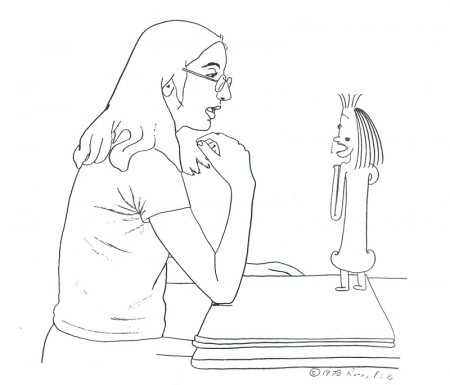
Kathy Rose’s Pencil Booklings (1978)
Kathy Rose also plays with the magical transformations of an animator character. Mirror People (1974) and The Doodlers (1975) both rely upon the protagonist’s constantly evolving physical shapes in an eerie, surrealistic world. In Pencil Booklings (1978), the artist/character (who resembles Rose) is represented more naturalistically through rotoscoping. Within the narrative she is pulled into the world of her imaginative creation and eventually back out of it, her identity assured by her exploration of the creative process itself.
Joanna Priestley‘s Voices (1985:) also relies upon the artist’s physical presence as well as her v ice to comment on her self-image. As a likeness of the filmmaker addresses an anthropomorphic (and smart-alecky) mirror, she describes first her bodily-related fears of aging, gaining weight, and wrinkles. As she succumbs to her preoccupation with fear itself, she gives vent to increasingly cataclysmic horrors that are visually portrayed— things that go bump in the night, monsters of the id, nuclear holocaust. The background prattle provides a counterpoint to the character’s self-absorbed fears creating a tongue-in-cheek commentary that suggests women’s fears about themselves are a culturally induced neurotic obsessiveness.
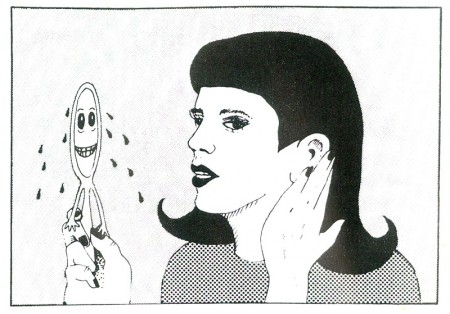
Joanna Priestly’s Voices (1985)
It is important to note that these artists depart from the traditional Hollywood use of sound, the acoustical enhancement of nature. Although the cartoon world may always be seen as inherently fantastic, the animation studio’s use of sound helped reinforce the notion of a spatial and physical world. These animators employ layers of sound effects and music to destabilize the spectator and to stress the fantastic itself.
Emily Hubley, the daughter of animators John and Faith Hubley, carries the metamo-phosing, autobiographic subject to new intensities. In Delivery Man (1982), she presents a simply drawn, ever-changing abstract self in an equally volatile, abstracted world. Less the object of whimsical artistic introspection than the subject of her fearful dreams relived, the constant visual metamorphosis supports a remembered vision of personal traumas. The woman’s personal narrative of five key dreams involving her birth, her mother’s surgery, and her father’s death during surgery visualize the crisis of familial relationships, development and sexual identity that comprise the subjects of many patients’ transactional analysis.
Kathy Rose has extended the woman animator’s autobiographic involvement to a redefinition of the medium itself. Her Primitive Movers (1982) is a 30-minute piece that combines animation and Rose’s dance performance in front of the moving images. The animation is a constantly moving, colorful backdrop of lifesized dancers who evoke series of art styles—from Egyptian to Cubist to Art Deco. Their relentlessly rhythmic, angular movements provide not so much a chorus line for Rose’s sharply expressive movements but a fluid commentary on changing spatial relations, perspective, and Rose’s intertwining of 2 and 3 dimensions, as well as her bodily interaction with them.
In this regard, several women animators connect their work to the history of art in ways that allow them to reconstitute woman’s place—no longer the object of male desire, but as the controlling subject. Maureen Selwood‘s Odalisque (1981) is, perhaps, the best example. In a humorous inversion of the history of western painting, Selwood portrays her odalisque as the subject who imagines and controls the flow of images. This female is no longer the prisoner of other artists.
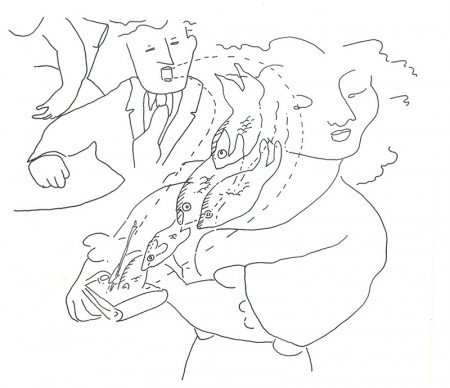
Maureen Selwood’s Odalisque (1981)
Selwood calls attention to a more naturalistic figuration as the basis for a realism regarding women in Western art. By juxtaposing two styles in a jarring fashion, she poises fluid, graceful motion associated with the feminine against the disintegration and evaporation of form associated with the cartoon world. Made with the aid of romance and adventure—as a cafe artist and an opera singer—in these dreams, she deflates as male fantasies the romantic conventions usually associated with these constructs. In each sequence, she escapes the conventional confines of the fantasy that would relegate Woman to passivity or death and flows back to her living room, her visually nurturant world.
Whether there is an inherently feminine language in these works as well as in women’s writing, visual arts, and other expressive arts has been a topic of much feminist discussion in the 1970s and 1980s. Some critics maintain that even acknowledging the existence of feminine language does not insure that such “inscriptions of women’s voices” will be necessarily heard by all audiences. Female filmmakers frequently rely upon existing codes and conventions no matter how much they are filtered through their own vocabulary. In addition, their audiences may choose to interpret the films within the confines of already established canons, an act sometimes amplified by the films’ marketing and critical reviews.
What is at stake here is not the discovery of a feminine or feminist aesthetic running through women’s animated films, but the ways in which contemporary animators collectively construct feminist experience. They rely upon devices usually associated with expressive animation—physical metamorphosis, strongly-defined character personalities, and dream-like fantasy logic. But they represent these processes by defining women as their subjects, presenting specifically female sexual and non-sexual fantasies, and imagining self-identity and fears through one’s physical changes and fluidity as well as through controlling the environment outside oneself.
Commentary &Photos 18 Jul 2010 07:26 am
More Things I Love
- A couple weeks back, I posted some photos of things I love around my studio. When you have a place like I do, and you’re as much of a gatherer as I am, things start piling up. There are in the maelstrom I call my workplace a number of things I absolutely love and love looking at.
Here are more of them:
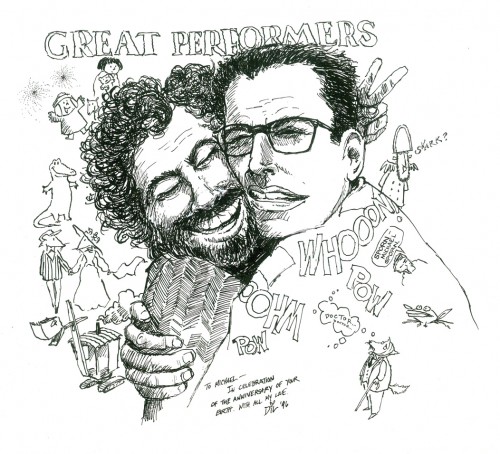
John Dilworth did this drawing of me with him surrounded by
some of the characters from my films. The picture came from
a photo taken of the two of us up at Lincoln Center.
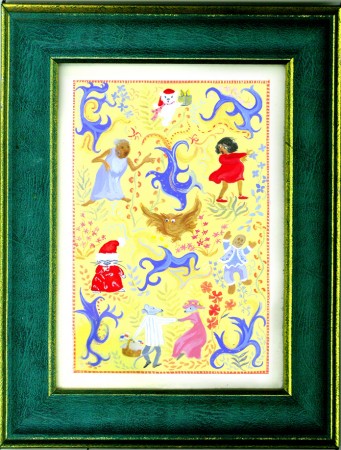
Laura Bryson did this little jewel of a painting – almost a Persian
miniature – of some of the bits from a number of my films.
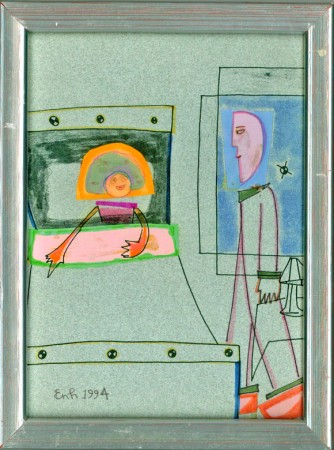
Emily Hubley gave me this great framed drawing.
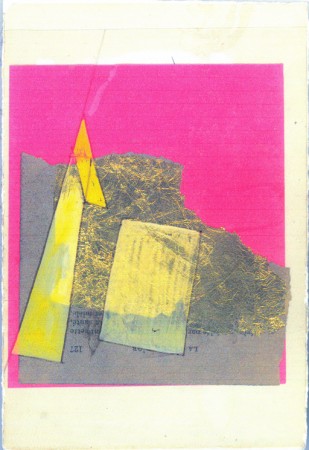
Bridget Thorne collaborated with her son, Matthew,
on this illustration that says everything to me.
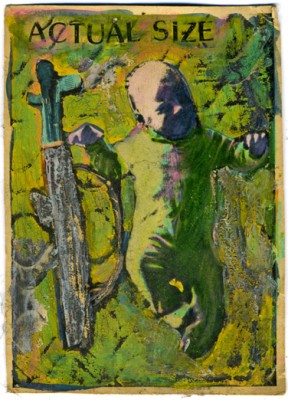
But then this was the first time they collaborated as mother/son.
Here’s Bridget’s birth announcement for Matthew many years ago.
Away from the art, here are some more things:
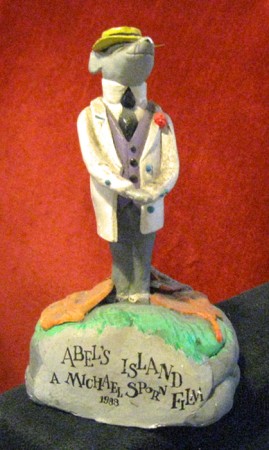
When we were completing Abel’s Island, John Dilworth made this
little sculpty statue of Abel. His walking stick has long been lost.
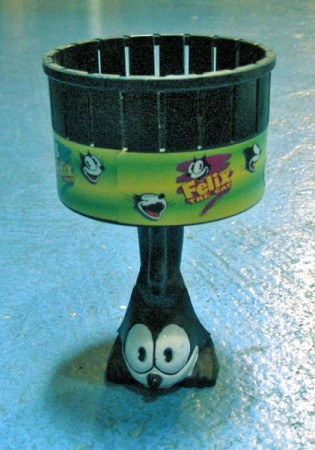
Wendy’s, at one time, gave away this little zoetrope
(that never really worked.)
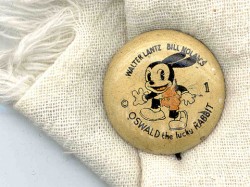
I love this Oswald the Rabbit pin which was a giveaway
for all lovers of the Bill Nolan rabbit back in 1931.
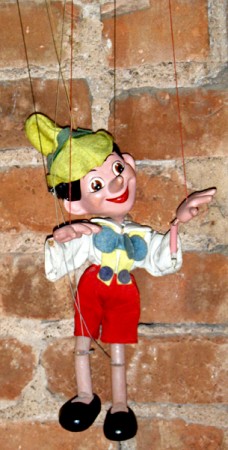
I treasure this Pinocchio marionette, that was given to me by my
beloved Heidi as a birthday gift many years ago. The puppet is an
antique made of a wood pulp that they used before they invented plastic.
Commentary &Daily post 16 Jul 2010 06:45 am
Drips and Drabs
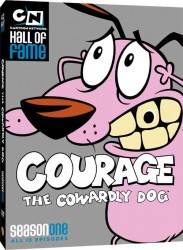 - The totally-lacking-courage, Cartoon Network is finally realeasing the official DVD of the first season (mind you it’s only the first season) of John R. Dilworth‘s masterful series Courage the Cowardly Dog.
- The totally-lacking-courage, Cartoon Network is finally realeasing the official DVD of the first season (mind you it’s only the first season) of John R. Dilworth‘s masterful series Courage the Cowardly Dog.
The DVD hits the stores on January 20, 2010 some 11 years after it was first aired. How embarrassing for a network that claims it has to move into live action to finally get strong. If they had taken advantage of the brilliant properties in their hands – all those under the original creative team – they might have been a bit more original, successful, and useful. Now it’s just a network without a real name.
The Sundance Channel has released ANIMATION BIZARRO 2 – a collection of seven animated shorts made by some of the most provocative and unique Canadian animators/artists:
- Each film was chosen for its diversity, quality and individuality. The episodes provide a range of color and bizarre visions of the world as depicted through a variety of animation styles including: cel, paper cut outs, stop motion and CGI. The films touch on a variety of moods (funny, touching and sardonic).
The series features the work of established veterans like Mad Magazine legends Al Jaffee and Sergio Aragones, and emerging animators like Brandon Blommaert and Sean Stoops. Their work, juxtaposed with our other featured artists like Robbie Conal, Steve Brodner and the emerging new stars of the Hot House program, really tells a bigger story of the progression of modern humor, cartooning, political satire and comedy in art. We think this will be
both fascinating and thoroughly entertaining for the diehard fans and
general audiences as well.
Following the launch, Sundance will add new videos, images and interviews to the Animation Bizarro site on each remaining Monday throughout the month, so please keep checking the site for additional content.
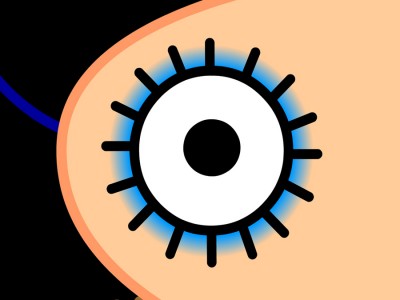 - Bill Benzon continues his study of Nina Paley’s feature length film, Sita Sings the Blues. In his current essay on the blog New Savannah, he writes about Ritual in Sita Sings the Blues, Part 1.
- Bill Benzon continues his study of Nina Paley’s feature length film, Sita Sings the Blues. In his current essay on the blog New Savannah, he writes about Ritual in Sita Sings the Blues, Part 1.
It’s nice to see Nina’s film taken so seriously. It should outlive its shelf life.
- Tom Hachtman’s Gertrude’s Follies got a nice writeup in The Comics Journal. That strip deserves all the attention it can muster. In my opinion, Tom’s the equivalent of a modern day Milt Gross, only he has received enough praise.
